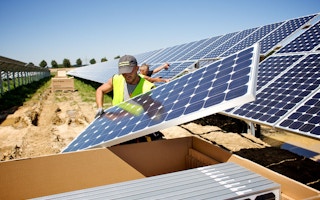Renewables became the dominant source of electricity in Europe’s power grid for the first time last year, a new study shows.
To continue reading, subscribe to Eco‑Business.
There's something for everyone. We offer a range of subscription plans.
- Access our stories and receive our Insights Weekly newsletter with the free EB Member plan.
- Unlock unlimited access to our content and archive with EB Circle.
- Publish your content with EB Premium.
In a year when pandemic lockdowns caused energy demand to dip across the bloc, clean energy technologies overtook fossil fuels as the slump hit conventional and more expensive power supply, according to the European power sector report by energy and climate think tanks Ember and Agora Energiewende.
Driving Europe’s energy transition are rapid growth in wind and solar generation, which has almost doubled since 2015 and delivered one-fifth of the region’s electricity in 2020, and robust carbon pricing that has seen the share of coal halve over the past five years.
This transformation is expected to gain momentum as European nations move to become carbon neutral by 2050. To achieve its climate goals, the continent will need to install twice the green power capacity it added in 2020, every year until mid-century, experts say.
Together, renewables generated 38 per cent of Europe’s power in 2020, overtaking the 37 per cent market share of fossil fuels, with coal contributing 13 per cent. Nuclear energy supplied the remaining 25 per cent of Europe’s power. The highest shares of wind and solar were seen in Denmark (61 per cent), Ireland (35 per cent), and Germany (33 per cent).
Carbon taxes levied across the continent—which are in excess of US$100 per tonne of carbon emissions in some countries—also meant that gas became Europe’s cheapest form of conventional power generation last year, even undercutting lignite, the dirtiest type of coal, for the first time.
Gas has been touted as a cleaner-burning fuel due to its lower carbon dioxide emissions, but climate experts have raised alarms over methane—a powerful greenhouse gas—emitted during its production, transportation and combustion.
“It is significant that Europe has reached this landmark moment at the start of a decade of global climate action,” said Dave Jones, Ember’s senior electricity analyst and the lead author of the report. “Rapid growth in wind and solar has forced coal into decline but this is just the beginning.”
The EU aims to cut carbon emissions by 55 per cent compared to 1990 levels by 2030. Research shows this would require the region to almost entirely phase out coal this decade, and the bloc has placed big bets on solar and wind to replace the fuel.
Renewables are also needed to meet Europe’s rising power demand from electric cars, heat pumps, and green hydrogen production. To generate more of the fuel, the bloc has set itself an ambitious target to install 40 gigawatts (GW) of electrolysers by 2030, up from less than 1 GW in place globally today.
The new report comes as EU countries consider committing to an aggressive stance on climate diplomacy that would see the bloc call for a global phase-out of coal and discourage further investment in fossil fuels.
Asia’s energy shift, too, is speeding up
Even as Europe’s energy transition kicks into higher gear, so does Asia’s, said Assaad Razzouk, chief executive of Singapore-based renewables company Sindicatum.
China, for instance, added almost 72 GW of wind power last year, more than double its previous record. It added 48 GW of solar capacity, the most since 2017. These additions dwarf the 26 GW of renewables that the EU installed in 2020.
In India, bids for new solar ventures hit record lows in 2020, affirming that coal is no longer the cheapest source of electricity. The country added 9 GW of clean generation capacity last year, and the International Energy Agency expects it to be the largest contributor to the global clean energy upswing this year, with annual additions doubling from 2020.
Even Southeast Asia—which has long seen poor progress—has begun to catch up, with Vietnam leading the way. Clean power capacity has skyrocketed across the region in recent years, although more work lies ahead to hit its target of sourcing 23 per cent of its primary energy from renewables by 2025.
That said, Asia was responsible for 80 per cent of the world’s coal power generation last year. In 2018, the United Nations’ Intergovernmental Panel on Climate Change said global coal use would need to fall by 59 to 78 per cent below 2010 levels by 2030 to give the world a chance of limiting heating to 1.5 degrees Celsius.
“Asia’s energy transition is key to capping climate change,” Ember’s Jones told Eco-Business. “The key action for Asian nations to take, now that many have committed to net-zero emissions by mid-century, is to focus on phasing out coal this decade.”
While the increasing pace of wind and solar deployment in China and India have made them world leaders in the energy transition, Europe’s share of renewables in its electricity mix is twice the global average, making the continent a critical hotbed of innovation to better integrate more variable renewables into power grids.
“Europe will give Asia and other nations across the world confidence that wind and solar can power the majority of electricity systems,” said Jones.










